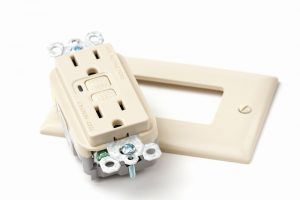 Our electricians in Chicago, IL provide many different services to help homes upgrade to modern electrical demands and the highest safety standards. One of the ways our electricians can improve household safety is with the installation of AFCI and GFCI outlets.
Our electricians in Chicago, IL provide many different services to help homes upgrade to modern electrical demands and the highest safety standards. One of the ways our electricians can improve household safety is with the installation of AFCI and GFCI outlets.
We’ve written before about these outlets, which you can easily recognize because they have buttons between the socket pairs marked TEST and RESET. In this post, we want to address what makes the two different and where we recommend having them installed in a house.
These Are Both Vital Safety Upgrades
Before talking about the difference between AFCI and GFCI outlets, we want to stress that you don’t need to choose which type your house needs. The house needs both. They provide improved safety conditions for a household, and if you don’t have either type located anywhere in your house, please speak to our electricians as soon as possible to arrange for making the upgrades. Our electricians know exactly where to install these outlets.
AFCI Outlets Stop Electrical Fires
An AFCI outlet is designed to stop electrical fires from occurring in a house because of an arc fault. The initials AFCI stand for Arc Fault Circuit Interrupter. If you don’t know what an arc fault is, it’s a situation where electricity leaps from one wire to another when it shouldn’t. Arc faults often happen because of deteriorating and loose insulation in an older home. But they are also a common side effect of amateur or sloppy electrical installations—one of the many reasons you should never try to handle wiring jobs in your house on your own. Another frequent cause of arc faults is when a nail is accidentally driven into wires.
The AFCI outlet detects when an arc fault occurs and trips a circuit breaker in the outlet to stop electrical flow. This prevents the electrical current leaping from one wire to another from triggering a house fire.
Where to Have AFCI Outlets Installed: the family room, the dining room, bedrooms, dens, closets, hallways, sunrooms. They’re a general-use outlet for any room where a GFCI outlet isn’t the better choice.
GFCI Outlets Prevent Electrical Shocks
While an AFCI outlet protects the house from fires, a GFCI outlet protects a person from receiving a high-voltage shock. GFCI stands for ground fault circuit interrupter. A ground fault means electricity from the outlet is finding a way to reach the ground through something it shouldn’t—i.e. a person.
The way a GFCI outlet works is that it monitors the current from the hot side of the outlet to the neutral side. The voltage levels are supposed to be the same as the electrical current makes a circuit through whatever appliance is plugged into the outlet. If there’s a drop in current on the neutral side, it means voltage is passing through an object to reach the ground. This usually means its passing through a person. The outlet’s breaker immediately cuts off flow to prevent further harm.
Where to Have GFCI Outlets Installed: Any room with a potential for electrical shock because of the presence of water—the kitchen, bathrooms, the laundry room, crawlspaces. They’re also recommended for outdoor outlets.
ServiceMax is open 24/7—All Day, Every Day! Schedule electrical service upgrades with our licensed Chicagoland electricians.